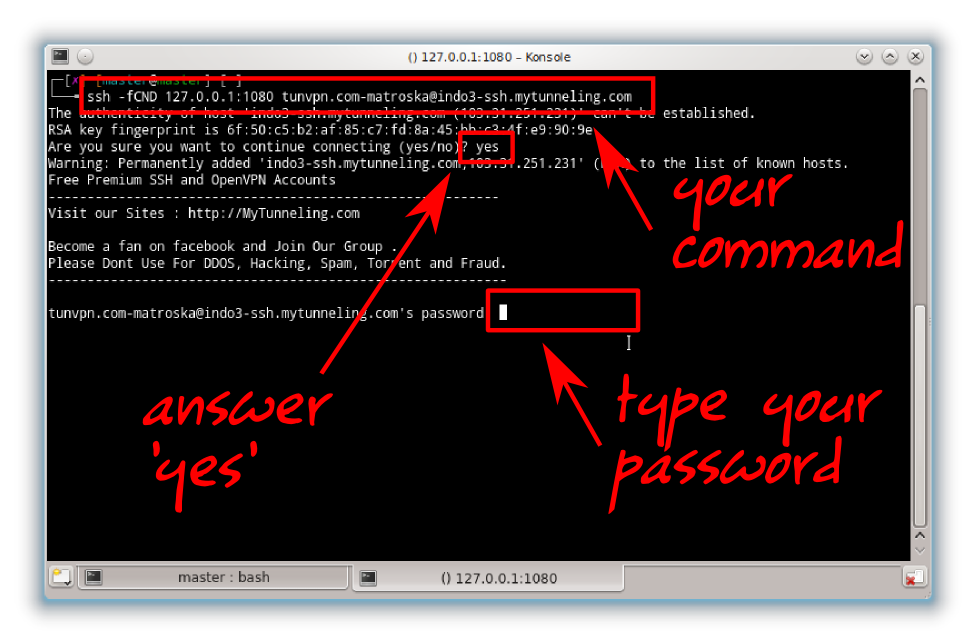

ProxyJump is a relatively new setting that I find somewhat more intuitive to use then a Prox圜ommand. HOST TO PROXY VIA: the bastion or instance that you want to use as a proxy. That way I won't need to use any commandline flags and can simply type ssh Destination and be done with. Check you server logs for that.Īlso typically the username on my workstation won't match to the one that gets assigned on either Bastion or Destination so I prefer to set all settings explicitly in my configs. ssh/config file so that I can log into the Destination server with a single command?ĭebug with one or more ssh -v flags from from the client and check the logs on the relevant server to see where the problem is.Īll too frequently I have different keys for different customers, sites and projects, and I run into a MaxAuthTries setting of the remote ssh server when ssh-agent is still trying every potential key and hasn't reached the correct one yet. How do I correctly pass the SSH key from my local to the Bastion server without having to store it on the server? Can I configure all this via. Ssh_exchange_identification: Connection closed by remote host ssh/config file looks like this: Host Bastionīut when I run ssh -A responds with: Permission denied (publickey). ssh/config file in such a way that I can SSH to the Destination server using one command from the laptop. I am able to connect to the Bastion and use agent forwarding to pass the SSH key over and then connect separately from the Bastion to the Destination server. Its IP address is visible only to Bastion. However, Destination cannot be accessed from the Internet. Here, we use the port 8080 as the local proxy port. Second, set the dynamic port forwarding as in the following figure. You can input the host only and PuTTY will ask for the username.
#SSH PROXY SETUP PLUS#
(For the curious, the visible browser extensions are Checker Plus for Gmail, Ad Block Plus, 1Password, JSONView, Momentum, and of course SwitchyOmega.I have a network topology like this: Laptop -> Bastion -> Destinationīastion and Destination are EC2 instances using the same SSH key for SSH access. First, input the username and host name as in the following figure. If you opted out of the auto-switch, you can toggle between the Direct and Proxy connections in the extension: Once you have the tunnel running ( proxy-on) and the auto switch rule in place, all you need to do is go to the desired URL. It’s also worth creating a Auto Switch rule so that you don’t have to manually toggle between the appropriate proxy setting: If you are using the SwitchyOmega extension, it will look like the following: The proxy will need to be SOCKSv5, localhost, port 8080. If you are using Chrome, you can use the SwitchyOmega browser extension (or its predecessor SwitchySharp) to setup the proxy. Put the following in your ~/.bash_profile: # For My Proxy TunnelĪlias proxy-check='ssh -O check my-proxy'Ĭontrol socket connect(/Users/quinn/.ssh/sockets/ :22): No such file or directory Create the ~/.ssh/sockets directory if it does not already exist.

Here we are forwarding 8080, but your needs may differ.

Replace admin-user with the desired user.Replace x.x.x.x with the desired IP address, most likely a jumphost.Replace the filepath for the key pair used in IdentityFile as needed.Rather than create the tunnel by running ssh -D 8080 -f -C -N $, it made more sense to setup the port forwarding in ~/.ssh/config and create a couple aliases that allowed us to quickly start/check/exit the tunnel.Īdd the following to your ~/.ssh/config file: Host my-proxyĬontrolPath ~/.ssh/sockets/% %h:%p Recently we had a client whose Openstack configuration required us to use a SOCKSv5 proxy to access the Horizon Dashboard.


 0 kommentar(er)
0 kommentar(er)
